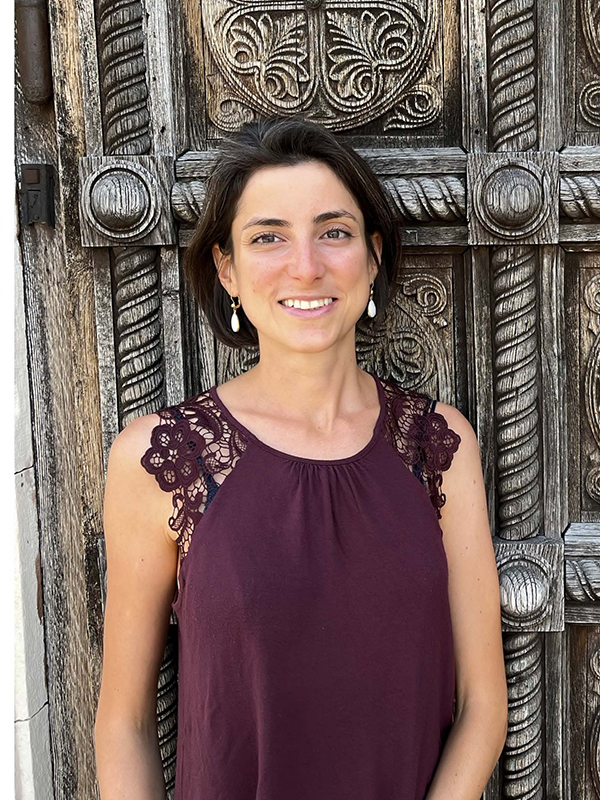
Pennsylvania Üniversitesi’nde Bizans Sanatı alanında doktora adayı olan Galardi’nin doktora tez projesi, ” Rölyeflerdeki Bizans İkonları” başlığını taşıyor ve Orta çağ Ortodoks Hıristiyanlığında kabartma formun yerini yeniden ele alıyor. Galardi’nin analizi, malzeme ve boyut açısından kabartma ikonaları kapsıyor ve kabartma imgenin iki ve üç boyutlu niteliklerindeki karmaşıklığını çözmek için öncelikle maddesellik, fenomenoloji ve ölçek sorularıyla ilgileniyor.
Galardi, Penn’in lisansüstü programına katılmadan önce Verona Üniversitesi’nde lisans, Université Paris 1 Panthéon-Sorbonne ve Courtauld Sanat Enstitüsü’nde yüksek lisans eğitimi aldı. 2021-2022 yıllarında Yunanistan’ın Atina kentindeki Gennadius Kütüphanesi’nde M. Alison Frantz araştırmacısıydı.
The Byzantine Icon in Relief
Elisa Galardi
The 2022–2023 ANAMED fellowship provided me with the essential time and intellectual resources to carry out research for my PhD thesis on the Byzantine icon in relief. The icon is the paradigmatic object of Orthodox Christianity. In Byzantium, it was a herald of orthodoxy, a protagonist in public rituals of the church and the state, and a focus of devotional practices in private. Studies on the plurality of the icon’s functions have largely privileged panel paintings to such a degree that the “Byzantine icon” has become synonymous with the medium of paint. However, icons existed in a range of media and sizes in the form of reliefs. They were impressed onto seals, molded in ceramic and bronze, worked into cameos, and carved in steatite, ivory, marble, and wood.
The significant presence of these icons in the material record raises important questions for our understanding of Byzantine culture and its place in broader narratives of art history. The sculptural qualities of the icon in relief inevitably emphasize the materiality and tangibility of the holy portrait, defying the theological negation of matter as an important component of the icon’s veneration. Moreover, the ontological ambiguity of the relief, existing in between two- and three-dimensions, challenges the commonplace assumption that sculpture had no place in the Orthodox Christian world. Byzantium, following the Biblical second commandment prohibiting the worship of idols, is said to have ceased to produce statues after the seventh century.
Focused on the relief icon across media and size, my dissertation rethinks the conflict between religious theory and practice and the presumed marginal role of sculpture in the Orthodox tradition. I explore the endurance of the icon in relief in the medieval Orthodox milieu and reflect on the implications of its presence for current narratives on the formation of the sculptural tradition in Christian contexts.
The thesis unfolds across four chapters framed by an introduction and a conclusion. Each chapter is devoted to one aspect of the holy image as discussed in the sources, namely matter, form, color, and shadow.
During my time at ANAMED, I have focused on writing the chapter on form. Building upon Michael Baxandall’s concepts of the artist’s “Charge” and the artist’s “Brief,” I explore the ways in which the formal qualities of the relief could be deployed to create an effective icon in accordance with the theory and the rituals practiced around the sacred image.[1] Baxandall’s Charge is a task given or taken up by an artist with the expectation that the result will satisfy the conditions for the creation’s intended use or scope. In the Byzantine icon, I articulate the Charge as the re-presentation of a prototype’s form in a way that was suitable for veneration. I thus explore how three features of the image in relief, namely its patterns and details, its depth/projection, and its textures, could respond to the involvement of sight and touch in veneration while presenting profound theological precepts. The Baxandallian Brief is the bundle of material, cultural, social, or economic circumstances that qualifies the Charge. I use the Brief to particularize observations that could befit any relief to a specific icon in relief, crafted in a specific medium, and experienced under peculiar circumstances.
In addition to working on the chapter, in the fall I drafted and submitted an article (accepted but not published as of April 2023) issued from the introduction of my dissertation. The article analyzes Goldschmidt and Weitzmann’s study of Byzantine ivories from 1934 and retraces its entanglements with contemporaneous art theories.[2]
Besides intensive time spent reading and writing at libraries at ANAMED, the DAI Istanbul (The Istanbul Department of the German Archaeological Institute), and SALT, numerous visits to museums and Byzantine and Ottoman monuments in İstanbul, Trabzon, and İznik have stimulated my thinking on questions relevant for my PhD and beyond.[3] A visit to the Anatolian Weights and Measures gallery at the Pera Museum, guided by collection supervisor Yavuz Selim Güler, gave me new perspectives on the topic of “weight,” which I address in the first chapter of my dissertation.[4] In Trabzon, the exploration of numerous sites with a terrific group of researchers and friends allowed me to fruitfully compare the use of architectural reliefs in monuments from Constantinople and the Black Sea capital.
Finally, during my time at ANAMED I had the opportunity to connect with local and foreign researchers and to discuss my ideas and larger methodological questions with a group of brilliant scholars in informal settings.
[1] Michael Baxandall, Patterns of Intention. On the Historical Explanation of Pictures (New Haven: Yale University Press, 1985).
[2] Adolph Goldschmidt and Kurt Weitzmann, Die byzantinischen Elfenbeinskulpturen des X.–XIII. Jahrhunderts: Reliefs (Berlin: B. Cassirer, 1934).
[3] Regrettably, the Byzantine gallery of the Istanbul Archeological Museums is currently closed and inaccessible.
[4] In my ANAMED blog post, I share some of my perspectives on the topic.

